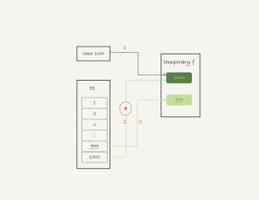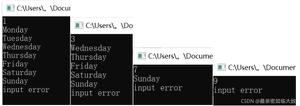C++顺序表的基本操作(使用模版类)
本文实例为大家分享了C++顺序表的基本操作,供大家参考,具体内容如下
一、遇到问题:
原因:类的函数定义不能放在SeqList.cpp中,必须放在Seqlist.h(类的函数声明和定义放在同一个文件下)中,否则
会出现以下问题。

二、实现程序:
1.SeqList.h
#ifndef SeqList_h
#define SeqList_h
#include <iostream>
using namespace std;
const int defaultSize = 100;
template<class T>
class SeqList{
public:
SeqList(int sz = defaultSize); // 构造函数
SeqList(SeqList<T>& L); // 复制构造函数
~SeqList(); // 析构函数
int Size(); // 重载虚函数:计算表最大可容纳表项个数,限制权限,类外无法直接获取maxSize
int Length(); // 计算表长度
int Search(T x); // 搜索x在表中位置,函数返回表项序号
int Locate(int i); // 定位第i个表项,函数返回表项序号
bool getData(int i, T& x); // 取第i个表项的值
void setData(int i, T x); // 用x修改第i个表项的值
bool Insert(int i, T x); // 在第i个表项后插入元素x
bool Remove(int i, T& x); // 删除第i个表项,通过x返回
bool isEmpty(); // 判断表是否为空,空则返回true;否则,返回false
bool isFull(); // 判断表满否,满则返回true;否则,返回false
void Input(); // 输入数据建立表
void Output(); // 打印表
void Sort(); // 排序
SeqList<T> operator=(SeqList<T>& L); // 表整体赋值
private:
T *data; // 存放数组
int maxSize; // 最大可容纳表项的项数
int last; // 当前已存表项的最后位置(从0开始)
void reSize(int newSize); // 改变数组空间大小
};
template <class T>
SeqList<T>::SeqList(int sz) {
// 构造函数,通过指定参数sz定义数组的长度
if(sz > 0) {
maxSize = sz;
last = -1; // 置表的实际长度为空
data = new T[maxSize]; // 创建顺序表存储数组
if(data == NULL) {
cerr << "动态内存分配失败!" << endl;
exit(1);
}
}
}
template <class T>
SeqList<T>::SeqList(SeqList<T>& L) {
// 复制构造函数,用参数表中给出的已有顺序表初始化新建的顺序表
// 如果没有定义复制构造函数,系统会自动建立一个复制构造函数
maxSize = L.Size(); // 最大可容纳的个数
last = L.Length() - 1; // 数组最后的位置
T value;
data = new T[maxSize]; // 创建顺序表存储数组
if(data == NULL) {
cerr << "动态内存分配失败!" << endl;
exit(1);
}
for(int i = 1; i <= last+1; i++) {
L.getData(i, value); // 取第i个位置的值
data[i-1] = value;
}
}
template <class T>
SeqList<T>::~SeqList() {
// 析构函数
delete []data;
}
template <class T>
void SeqList<T>::reSize(int newSize) {
// 私有函数:扩充顺序表的存储数组空间大小,新数组的元素个数为newSize
if(newSize <= 0) { // 检查参数的合理性
cerr << "无效的数组大小" << endl;
return;
}
if(newSize != maxSize) { // 修改
T *newArray = new T[newSize]; // 建立新数组
if(newArray == NULL) {
cerr << "动态内存分配失败!" << endl;
exit(1);
}
int n = last + 1;
T *srcPtr = data; // 源数组首地址
T *destPtr = newArray; // 目的数组首地址
while(n--)
*destPtr++ = *srcPtr++; // 复制:只是数据
delete []data; // 删除旧数组
data = newArray; // 复制新数组
maxSize = newSize; // 复制新数组:数据和内存空间
}
}
template <class T>
int SeqList<T>::Size(){
// 计算表最大可容纳表项个数
return maxSize;
}
template <class T>
int SeqList<T>::Length(){
// 计算表长度
return last+1;
}
template <class T>
int SeqList<T>::Search(T x){
// 搜索x在表中位置,函数返回表项序号:在表中的第几个位置;搜索失败:返回0
for(int i = 0; i <= last; i++) // 顺序搜索
if(data[i] == x)
return (i+1);
return 0;
}
template <class T>
int SeqList<T>::Locate(int i){
// 定位第i个表项,函数返回第i(1<= i <= last+1)个表项的位置,否则函数返回-1,表示定位失败
if(i >= 1 && i <= last+1)
return i-1; // 数组下标从0开始
return -1;
}
template <class T>
bool SeqList<T>::getData(int i, T& x){
// 取第i个表项的值
if(i > 0 && i <= last+1) {
x = data[i-1];
return true;
}
return false;
}
template <class T>
void SeqList<T>::setData(int i, T x){
// 用x修改第i个表项的值
if(i > 0 && i <= last+1)
data[i-1] = x;
}
template <class T>
bool SeqList<T>::Insert(int i, T x) {
// 在第i个表项后插入元素x
if(last == maxSize-1) // 表满,不能插入
return false;
if(i < 0 || i > last+2) // 参数i不合理,不能插入, last+2表示数组的最后面插入
return false;
for(int j = last; j >= i; j--)
data[j+1] = data[j]; // 依次后移,空出第i号位置
data[i] = x; // 插入
last++; // 最后位置加1
return true; // 插入成功
}
template <class T>
bool SeqList<T>::Remove(int i, T& x) {
// 删除第i个表项,通过x返回
if(last == -1) // 表空,不能删除
return false;
if(i < 0 || i > last+1) // 参数i不合理,不能插入
return false;
x = data[i-1];
for(int j = i-1; j < last; j++)
data[j] = data[j+1];
last--; // 最后位置减1
return true; // 删除成功
}
template <class T>
bool SeqList<T>::isEmpty(){
// 判断表是否为空,空则返回true;否则,返回false
return (last == -1 ? true : false);
}
template <class T>
bool SeqList<T>::isFull(){
// 判断表满否,满则返回true;否则,返回false
return (last == maxSize-1 ? true : false);
}
template <class T>
void SeqList<T>::Input() {
// 从标准输入(键盘)逐个数据输入,建立顺序表
int len;
cout << "开始建立顺序表,请输入表中元素个数:";
cin >> len;
if(len > maxSize) {
cout << "表元素个数输入有误,范围不超过:" << maxSize << endl;
return;
}
last = len - 1; // 数组最后位置
cout << "请输入建表的数据:" << endl;
for(int i = 0; i <= last; i++) // 逐个输入表元素
cin >> data[i];
}
template <class T>
void SeqList<T>::Output() {
// 将顺序表全部元素输出到屏幕上
for(int i = 0; i <= last; i++)
cout << data[i] << " ";
cout << endl;
}
template <class T>
void SeqList<T>::Sort() {
int flag;
T temp;
// 排序:从小到大
for(int i = 0; i < last; i++) { // 最后一个不用排了
flag = 0; // 标志该轮是否有交换, 0表示没有交换,1表示有交换
// 没有交换,说明已排好序,提前结束
for(int j = 0; j < (last - i); j++) { // 向后冒泡
if(data[j] > data[j + 1]) {
flag = 1;
temp = data[j+1];
data[j+1] = data[j];
data[j] = temp;
}
}
if(flag == 0) // 没有交换,提前结束程序
break;
}
}
template <class T>
SeqList<T> SeqList<T>::operator=(SeqList<T>& L) {
int size, value;
// 表整体赋值:顺序表整体赋值
size = L.Size();
if(maxSize != size) { // 表最大可容纳数小于L的
reSize(size); // 该变数组大小
}
last = L.Length() - 1; // 数组的最后位置
for(int i = 1; i <= last+1; i++) {
L.getData(i, value); // 取第i个位置的值
data[i-1] = value;
}
}
#endif /* SeqList_h */
2.main.cpp
#include "SeqList.h"
using namespace std;
int main(int argc, const char * argv[]) {
int choose, len, i, x, maxSize, loc; // val存储值,choose存储用户的选择
bool finished = false;
SeqList<int> L; // 声明SeqList对象
while(!finished) {
cout << "1:输入数据建立顺序表:" << endl;
cout << "2:顺序表的最大可容纳表项个数:" << endl;
cout << "3:顺序表的长度:" << endl;
cout << "4:搜索x在表中的位置:" << endl;
cout << "5:定位第i个表项:" << endl;
cout << "6:取第i个表项的值:" << endl;
cout << "7:用x修改第i个表项的值:" << endl;
cout << "8:在第i个表项后插入元素x:" << endl;
cout << "9:删除第i个表项:" << endl;
cout << "10:判断表是否为空:" << endl;
cout << "11:判断表满否:" << endl;
cout << "12:打印顺序表中的数据:" << endl;
cout << "13:将顺序表排序:" << endl;
cout << "14:退出:" << endl;
cout << "请输入你的选择[1-14]:" << endl;
cin >> choose;
switch(choose) {
case 1:
L.Input(); // 建立顺序表
break;
case 2:
maxSize = L.Size();
cout << "顺序表的最大可容纳表项个数为:" << maxSize << endl;
break;
case 3:
len = L.Length();
cout << "顺序表的长度为:" << len << endl;
break;
case 4:
cout << "请输入要搜索的值x:";
cin >> x;
i = L.Search(x);
if(i == 0)
cout << "没找到" << x << endl;
else
cout << x << "在表中的第" << i << "个位置" << endl;
break;
case 5:
cout << "请输入要定位的位置i:";
cin >> i;
loc = L.Locate(i);
if(loc != -1)
cout << "定位成功!在顺序表中下标为:" << loc << endl;
else
cout << "定位失败!" << endl;
break;
case 6:
cout << "请输入要取表中元素的位置i:";
cin >> i;
if(L.getData(i, x))
cout << "表中第" << i << "个表项的值为:" << x << endl;
else
cout << "取值失败!检查是否超范围取值" << endl;
break;
case 7:
cout << "请输入要修改的位置i和值x:";
cin >> i >> x;
L.setData(i, x);
break;
case 8:
cout << "请输入要插入的位置i和值x:";
cin >> i >> x;
if(L.Insert(i, x))
cout << "插入成功!" << endl;
else
cout << "插入失败!" << endl;
break;
case 9:
cout << "请输入要删除的表项的位置i:";
cin >> i;
if(L.Remove(i, x))
cout << "删除成功!删除的值为:" << x << endl;
else
cout << "删除失败!" << endl;
break;
case 10:
if(L.isEmpty())
cout << "表为空!" << endl;
else
cout << "表不为空!" << endl;
break;
case 11:
if(L.isFull())
cout << "表满!" << endl;
else
cout << "表未满!" << endl;
break;
case 12:
cout << "表中的数据为:" << endl;
L.Output();
break;
case 13:
cout << "表中的数据排序前:" << endl;
L.Output();
L.Sort();
cout << "表中的数据排序后:" << endl;
L.Output();
break;
case 14:
finished = true;
break;
default:
cout << "输入选择错误,请重新输入!" << endl;
}
}
return 0;
}
以上就是本文的全部内容,希望对大家的学习有所帮助,也希望大家多多支持。
以上是 C++顺序表的基本操作(使用模版类) 的全部内容, 来源链接: utcz.com/p/245149.html









